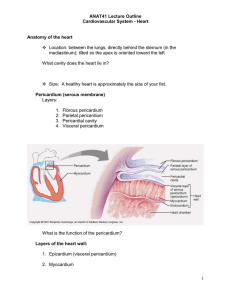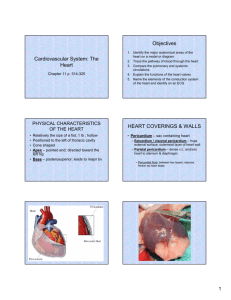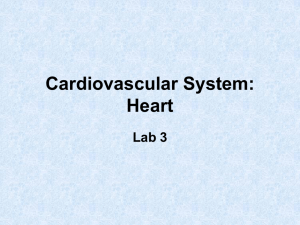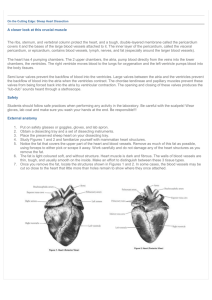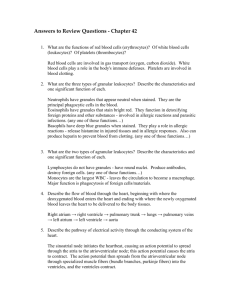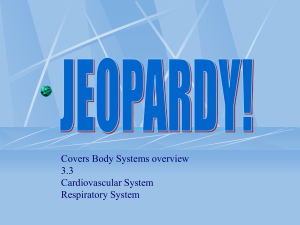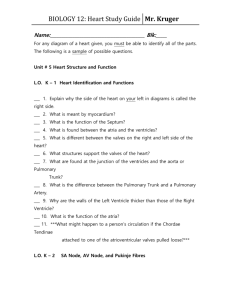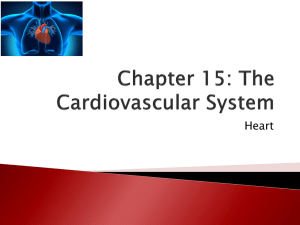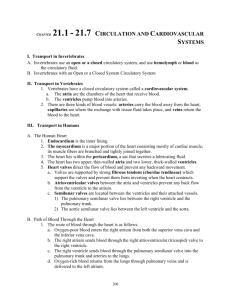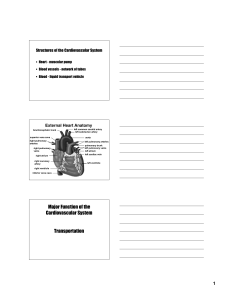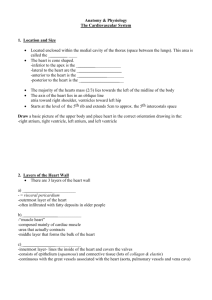Functional Organization of the Cardiovascular System
advertisement
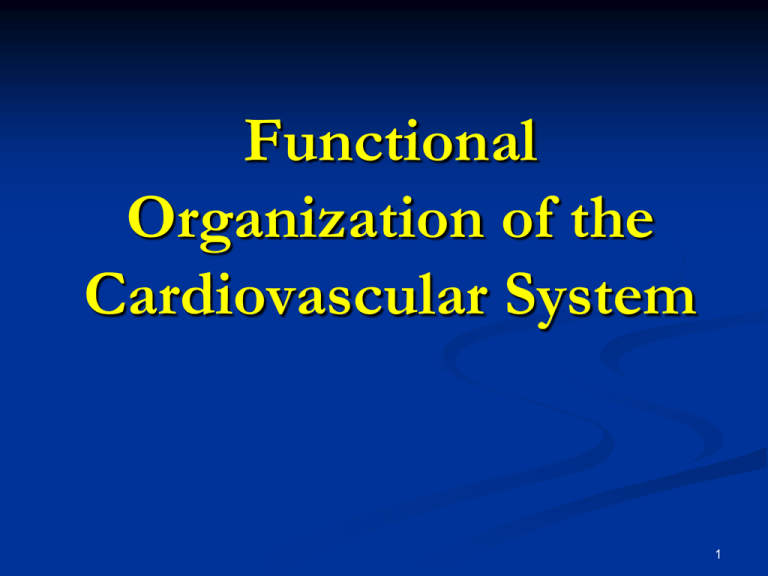
Functional Organization of the Cardiovascular System 1 Objectives Describe the functional organization of cardiovascular system List the functions of cardiovascular system. Describe the main function of arteries, capillaries and veins Describe the flow of blood through the chambers of the heart and through the systemic and pulmonary circulations. Compare and contrast the systemic and pulmonary circulation. 2 Functional Organization of Cardiovascular system HEART (PUMP) CARDIOVASCULAR SYSTEM VESSELS (DISTRIBUTION SYSTEM) Blood 3 Functions of the Cardiovascular system System circulates blood throughout the body. Transport of nutrients, oxygen, and hormones to cells throughout the body and removal of metabolic wastes (carbon dioxide, nitrogenous wastes, and heat). Protection of the body by white blood cells, antibodies, and complement proteins that circulate in the blood and defend the body against foreign microbes and toxins. Clotting mechanisms are also present that protect the body from blood loss after injuries. Regulation of body temperature, fluid pH, and water content of cells. 4 THE HEART Anatomy of the heart Hollow, muscular organ about the size of a clenched fist Positioned between two bony structures – sternum and vertebrae (CPR) 5 Heart: Two sided pump 6 7 8 9 10 Heart: 2 separate pumps (an atrium & a ventricle) Rightpumps blood through lungs Left pumps blood through peripheral circulation Atrium: weak primer pump for the ventricle Ventricle: the main pumping force Rt. Ventricle Lt. ventricle Pulmonary circulation Systemic circulation 11 Blood Flow Through and Pump Action of the Heart 12 Pulmonary circulation Starts at right ventricle Ends at left atrium Receives blood from right side of heart Carries blood between heart and lungs Blood perfusing the lungs is partially deoxygenated systemic circulation Starts at left ventricle Ends at right atrium Receives blood from left side of heart Carries blood between heart and other organ systems Blood perfusing the organ systems is oxygenated All blood flows through lungs Part of the blood go to different organ systems Low pressure, low resistance High pressure, high resistance 13 Heart Valves cont.. Atrioventricular (AV) valves (Tricuspid & mitral) Prevent backflow of blood from ventricles into atria during ventricular emptying Chordae tendinae Fibrous cords which prevent valves from being everted Papillary muscles 15 Heart Valves cont.. Semilunar valves (Aortic and pulmonary valves) Lie at juncture where major arteries leave ventricles Prevented from everting by anatomic structure and positioning of cusps No valves between atria and veins Reasons Atrial pressures usually are not much higher than venous pressures Sites where vecavae enter atria are partially compressed during atrial contractionnae 16 The fibrous skeleton of the heart Serves 3 roles: A mechanical base: atria anchored above and ventricles below Perforated by 4 apertures, each containing a valve Insulates the ventricles 17 Blood vessels 18 Arteries Structure of arterial wall Plentiful of elastic fibers….high compliance Function: Rapid transit passage-ways for blood from heart to tissues Pressure reservoir 19 Arteriole Very small artery that delivers blood to capillaries Structure Very little elastic tissue but thick layer of smooth muscle Function Regulating blood flow from arteries to capillaries by regulating resistance according to tissue metabolic needs. Contraction of smooth muscle (vasoconstriction) decrease arteriole diameter increase resistance decrease blood flow Relaxation of smooth muscles (vasodilation) increase arteriole diameter decrease resistance increase blood flow 20 Capillaries Microscopic vessels that connects arterioles to venules Structure Single wall layered vesseles (endothelial cells) Undergoes extensive branching Function: Exchange of nutrients and wastes between blood and tissue cells 21 Veins Carry blood from tissues to heart Structure: Thin wall Less smooth muscle and considerable amount of collagen Less elastic fibers Function: Passage ways back to heart Blood reservoir (capacitance vessels) 22
